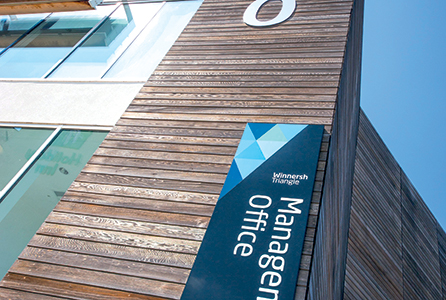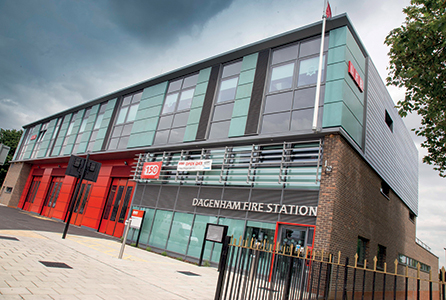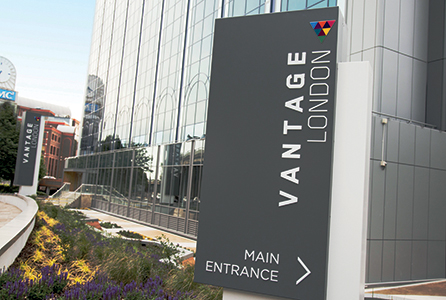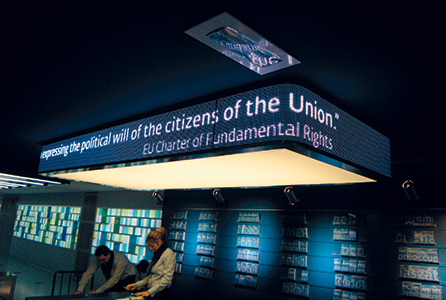
Avery Dennison says that products within its Façade Film range are suitable for residential and commercial projects
No matter what sort of situation the UK, and indeed global, financial markets find themselves in, there is one industry that always seems to plough on regardless—construction. Although its overall economic activity can vary significantly, it always remains a core contributor to the UK’s overall financial health. And be it a Premier League football team building a new stadium, or a blue chip company expanding its office network, construction is currently in a pretty sweet spot.
Given the amount of signage required in the examples listed here, and the types of work on offer this trend is of significant interest to those in our industry. The opportunities for expansion and growth in this sector are out there.
Here we speak to some of those companies that have made a success of themselves in this market, as well as suppliers that can support companies that are looking to make the move into architectural signage.
Intelligent design
One established service provider in the architectural signage market is Signbox, which has completed a colourful range of projects over the years. Mark Bartlett, managing director, is keen to highlight the company’s expertise in the market and reveals the process it has followed to ensure its place at the front of this sector.
“With intelligent design and application, our company consistently delivers award-winning visual communication strategies via traditional and pioneering signage methods across a number of market sectors, including corporate, education, healthcare, retail, hotel and leisure,” Bartlett says.
He continues: “With a proven formula based on contemporary design, technical innovation and engineering excellence, Signbox’s holistic approach continues to put the company at the forefront of architectural signage. Sourcing and implementing cutting edge technologies and high quality sustainable materials, we are renowned for delivering powerful interior and exterior signage projects for a diverse range of global brands in the UK, Europe, the Americas and the Far East—all of which are compliant, future-proof and visually arresting.”

Signbox, which has been operating for over 31 years, produces a range of architectural signage work. Pictured: A recent project at Winnersh IQ Business Park in Berkshire
Bartlett goes on to highlight the opportunities for sign-making companies in the architectural market, explaining that work from the UK construction sector accounts for 50 percent of sales over the last two years at Signbox, with the firm seeing growth within the commercial office fit-outs area in particular. However, he also warns of market uncertainty regarding Brexit and how the impact that it will have on the industry is likely to have an impact on this sector.
O Factoid: The UK construction sector accounts for 50 percent of sales over the last two years at Signbox. O
He explains: “Whilst there is still plenty of activity with projects on-site, we have seen cautious signs since the Brexit referendum and there is bound to be a hesitant period for investment ahead, until the post Brexit landscape is clear. Geographically, London will remain a powerhouse and we still see an opportunity for architectural signage, especially if the Government delivers on its promised major infrastructure projects.”

Signbox carried out architectural signage work for the London Fire Brigade in Dagenham
Bartlett adds: “Architectural signs require meticulous attention to detail for successful implementation and are often one of the final finishes to a building or campus. At Signbox, we like to engage with the architects, contractors or building managers at an early stage in the building process; to ensure provision for signage strategy, structural engineering, design, sustainable materials, lighting and planning consent. Project lead times vary from six weeks to 18 months or more and we are frequently asked to provide a day two maintenance schedule.”

Vantage London recently got the Signbox treatment, undergoing a makeover and now boasting various new signage
Let’s get digital
Also established in this sector is Messagemaker Displays, a UK-based LED and display manufacturer that is part of the Stocksigns Group. Supplying a wide range of standard LED signs and displays, the company is used to taking on the more complex briefs, often involving unusual shapes and visual effects.

Messagemaker has installed digital architectural signage in a number of locations, including the European Parlamentarium in Brussels, Belgium
Santosh Surabi, technical engineer at Messagemaker, says that the company has witnessed a jump in demand from companies in the architectural design sector. Surabi explains: “We have noticed an increase in the number of enquiries from architectural firms and interior designers who approach us with the vision of integrating visual technology into their architecture to create LED structures, which are aesthetically pleasing to the eye as well as serve the purpose of delivering information. With our ability to design, engineer, manufacture and install custom LED signs in different shapes and sizes, the possibilities are endless and the end results are quite beautiful.”

Santosh Surabi, technical engineer at Messagemaker Displays, says that the demand for LED and digital technologies in architectural signage jobs is one the rise
Indeed, as Surabi points out, technology advances, coupled with manufacturing on a volume scale have driven down prices to the point where LED displays are an economic and effective alternative to other display technologies. And as information delivery becomes ever more visual, the latest screen with full colour options and the capability to incorporate graphics, video and live news or Twitter feeds, have increased the appeal for LED displays, offering new opportunities for resellers, above and beyond public information and point of purchase applications.

Technology advances, coupled with manufacturing on a volume scale have driven down prices ”
Recent examples of projects undertaken by Messagemaker in the architectural and construction sector include the installation of vertical ticker displays at the RBS London Headquarters building, ticker displays covering a length of more than 40m at the Volvo Round the World Yacht Race media centre, as well as long ticker displays embedded in glass at the European Parlamentarium in Brussels, Belgium.
Surabi adds: “There is a growing trend among architects and designers towards the use of LED displays as an integral element in branding that integrates visually with building interiors and facades. The inclusion of digital elements in the spatial mix is now also gaining traction with planners and architects in opening up outside spaces to create emotional and interactive experiences that engage people.
“A key driver in the growth in demand for architectural use is the design freedom offered by modern LED technology. Comparatively lightweight with slim profiles, displays can be pole- or wall-mounted just about anywhere, inside or outside.
“Composed of individual LED tiles, systems can be combined to create infinitely variable curves to fit around curved shapes and run around corners, to create a turret effect or to reproduce sharp angles. The latest uses include semi-transparent mesh screens used as wall-mounted window displays for use in predominantly glass constructions.”
Setting yourself apart
Delving further into this market, and considering the types of materials that you need to complete architectural signage work, suppliers like Avery Dennison can lend a hand. Oliver Guenther, marketing director for Avery Dennison Graphics Solutions Europe, says that the choice of materials is critical when it comes to taking on the more innovative jobs this sector often throws up.
Guenther expands: “Building developers and owners are keen to find new ways to set themselves apart, and graphics materials have evolved to the point where architects and designers have more choices than ever before.
It’s really important to find not only the right materials for what can be very high profile projects, but also the in-depth technical support that ensures successful outcomes.
“Avery Dennison provides the material portfolios needed to customise projects and meet very precise briefs, as well as the training and support needed to go into a project with confidence about the final outcomes.”
With this in mind, Guenther draws attention to some of the options on offer from Avery Dennison. These include Façade Film, which Guenther says brings “fast, clean and easy redecoration” to residential and commercial projects.
He adds: “It is a durable, premium film that applies quickly in one layer over existing surfaces, and provides ‘spray paint’ smoothness straight away.”
Also available from Avery Dennison is the Wall Film series for indoor decoration, a range that has recently been expanded with the addition of three new textures that can add a unique canvas, crushed stone or stucco look to wall graphics.
In addition, signage options include solutions for building interiors, exhibitions, and floor graphics, with Avery Dennison offering window films, including translucent films and materials that are highly transparent so digitally printed graphics can be applied to an entire window, without the need for cut-outs.
Guenther adds: “This is a priority market for Avery Dennison, and one where we are making very substantial investment. That investment includes ongoing product development, pushing the boundaries of what graphics can do. We are also continuing to invest heavily in training and workshops.”
It is this level of commitment that shows just how active this sector of the market is, and how much importance major suppliers place on it. This is only good news for companies already operating in the market, as well as those considering a move into architectural signage, as they look to set themselves apart from the competition, and offer building and construction firms a creative, yet effective, solution to their signage needs.
Your text here...